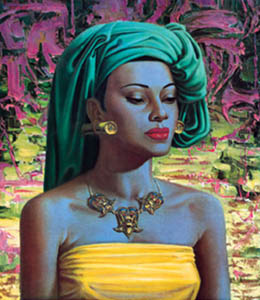ITEMS ON THE WALL. There was a great and persistent vogue for items on the wall, usually three, usually related. Fish. Ships. Turquoise crap. The mirror-mirror-on-the-wall arrangement gave me a start, because we had those candlesticks. They weren’t metal. They weren’t quite plastic. They were . . . platal. Mestic. The Soviets used the same substance for their medals. They came with candles - golden, twisted candles. I needn’t mention that they were never burned.
EVER.
Fans of the era will be somewhat astonished at the item in the lower left-hand corner: wha? Her? The blue lady! Type in “Kitsch blue lady” into google and she pops right up. It’s “Chinese Girl,” but it’s also known as the Blue or Gren lady. The artist was Vladimir Tretchikoff, and he made a nice piece of change from this work - licensing, no doubt - but didn’t like being called kitschy, and probably was irritated that the serious critics never took him, well, seriously.
The original looked better than the picture in the catalog. He also did this:

To my astonishment, they know who sat for the work: Monika Sing-Lee, who was working in a Chinese laundry in Johannesburg. Last year she was interviewed:
““To be honest, I never liked the green face that he gave me. When my sister-in-law brought me a print of Chinese Girl as a Christmas gift, I turned it down. She took it back and gave it to someone else.”
But the story has a remarkable end. She decided she wanted to own the picture, so she found the artist’s number - decades after she’d posed. He said he had one copy left, “and he had no intention of parting with it.”
So she went to his house. The rest is here.
|